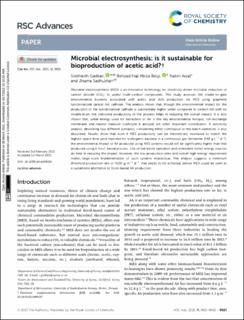| dc.contributor.author | Gadkari, Siddharth | |
| dc.contributor.author | Mirza Beigi, Behzad Haji | |
| dc.contributor.author | Aryal, Nabin | |
| dc.contributor.author | Sadhukhan, Jhuma | |
| dc.date.accessioned | 2022-03-28T10:15:40Z | |
| dc.date.available | 2022-03-28T10:15:40Z | |
| dc.date.created | 2021-09-14T17:08:41Z | |
| dc.date.issued | 2021 | |
| dc.identifier.citation | Gadkari, S., Mirza Beigi, B. H., Aryal, N. & Sadhukhan, J. (2021). Microbial electrosynthesis: is it sustainable for bioproduction of acetic acid? RSC Advances, 11(17), 9921-9932. | en_US |
| dc.identifier.issn | 2046-2069 | |
| dc.identifier.uri | https://hdl.handle.net/11250/2987893 | |
| dc.description.abstract | Microbial electrosynthesis (MES) is an innovative technology for electricity driven microbial reduction of carbon dioxide (CO2) to useful multi-carbon compounds. This study assesses the cradle-to-gate environmental burdens associated with acetic acid (AA) production via MES using graphene functionalized carbon felt cathode. The analysis shows that, though the environmental impact for the production of the functionalized cathode is substantially higher when compared to carbon felt with no modification, the improved productivity of the process helps in reducing the overall impact. It is also shown that, while energy used for extraction of AA is the key environmental hotspot, ion-exchange membrane and reactor medium (catholyte & anolyte) are other important contributors. A sensitivity analysis, describing four different scenarios, considering either continuous or fed-batch operation, is also described. Results show that even if MES productivity can be theoretically increased to match the highest space time yield reported for acetogenic bacteria in a continuous gas fermenter (148 g L−1 d−1), the environmental impact of AA produced using MES systems would still be significantly higher than that produced using a fossil-based process. Use of fed-batch operation and renewable (solar) energy sources do help in reducing the impact, however, the low production rates and overall high energy requirement makes large-scale implementation of such systems impractical. The analysis suggests a minimum threshold production rate of 4100 g m−2 d−1, that needs to be achieved, before MES could be seen as a sustainable alternative to fossil-based AA production. | en_US |
| dc.language.iso | eng | en_US |
| dc.rights | Navngivelse 4.0 Internasjonal | * |
| dc.rights.uri | http://creativecommons.org/licenses/by/4.0/deed.no | * |
| dc.title | Microbial electrosynthesis: is it sustainable for bioproduction of acetic acid? | en_US |
| dc.type | Peer reviewed | en_US |
| dc.type | Journal article | en_US |
| dc.description.version | publishedVersion | en_US |
| dc.rights.holder | © 2021 The Author(s). | en_US |
| dc.source.pagenumber | 9921-9932 | en_US |
| dc.source.volume | 11 | en_US |
| dc.source.journal | RSC Advances | en_US |
| dc.source.issue | 17 | en_US |
| dc.identifier.doi | https://doi.org/10.1039/D1RA00920F | |
| dc.identifier.cristin | 1934305 | |
| cristin.ispublished | true | |
| cristin.fulltext | original | |
| cristin.qualitycode | 1 | |

